1996 PONTIAC GRAND-AM engine
[x] Cancel search: enginePage 126 of 356
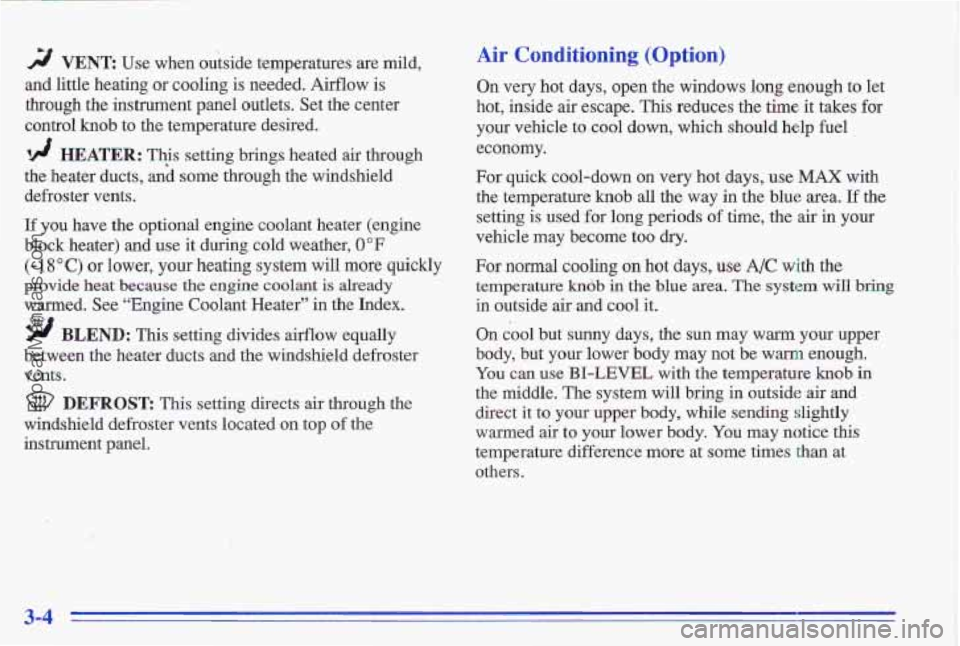
rF/ VENT Use when outside temperatures are mild,
and little heating or cooling is needed. Airflow is
through the instrument panel outlets. Set the center
control
knob to the temperature desired.
‘!! HEATER: This setting brings heated air through
the heater ducts, aid some through the windshield
defroster vents.
If you have the optional engine coolant heater (engine
block heater) and use it during cold weather,
0°F
(- 1 8 O C) or lower, your heating system will more quickly
provide heat because
the engine coolant is already
warmed. See “Engine Coolant Heater”
in the Index.
9 BLEND: This setting divides aeflow equally
between the heater ducts and the windshield defroster
vents.
DEFROST This setting directs air through the
windshield defroster vents located on top of the
instrument panel.
Air Conditioning (Option)
On very hot days, open the windows long enough to let
hot, inside air escape. This reduces the time it takes for
your vehicle to cool down, which should help fuel
economy.
For quick cool-down on very hot days,
use MAX with
the temperature
knob all the way in the blue area. If the
setting is used for long periods
of time, the air in your
vehicle may become too dry.
For normal cooling on hot days, use A/C with the
temperature
kndb in the blue area. The system will bring
in outside air and cool it.
On cool but sunny days, the sun may warm your upper
body, but your lower body may not be warm enough.
You can use BI-LEVEL with the temperature knob in
the middle. The system will bring in outside air and
direct it to your upper body, while sending slightly
warmed air
to your lower body. You may notice this
temperature difference more at some times than at
others.
3-4
ProCarManuals.com
Page 127 of 356

Hc-4ing
‘lix---lg the right control knob to HEATER and the
center control
knob clockwise sends some heated air
through the heater ducts toward your feet and some
through the defroster vents.
Veri, 3ys1
Use when outside temperatures are mild, and little
heating or cooling is needed. Turn the right knob to
VENT. Airflow is directed through the instrument panel
outlets. Set the center knob to the temperature desired.
VENT and HEATER are economical positions because Your Pontiac’s flow-through ventilation system supplies
the air conditioner compressor doesn’t run in these two outs\
ide air into the vehicle when it is moving. Outside
settings. This reduces engine load, resulting in improved
air will also enter the vehicle when the heater or the air
fuel economy.
If either setting fails to keep you conditioning fan is running.
comfortable, or causes your windows to fog up, turn
the right control
knob to one of the air conditioning Adjust the direction of
positions, or to DEFROST. airflow by moving the
If
you have the optional engine coolant heater (engine
block heater) and use it during cold weather, 0 OF ,
(- 18 O C) or lower, your heating system will more
quickly provide heat because the engine coolant is
already
warmed. See “Engine Coolant Heater”
the Index. louvered vents.
3-5
ProCarManuals.com
Page 130 of 356

Audio Systems
Your Delco@ audio system has been designed to operate
easiIy
and give years of listening pleasure. You will get
the most enjoyment out of it if you acquaint yourself
with
if first. Find out what your Delco system can do
and how to operate all its controls, to be sure you're
getting the most out of the advanced engineering that
went into it.
Setting the Clock for AM-FM Stereo
Press SET. Within five seconds, press and hold the
SEEK down mow until the correct hour appears on the
display. Press and hold the SEEK up arrow until the
correct minute appears on the display.
Setting the Clock for All Systems Except
AM-FM Stereo
Press and hold HR until the correct hour appears. Press
and hold
MIN until the correct minute appears. There
will
be a two-second delay before the clock goes into
time-set mode,
and the colon on the display will blink
while in this mode.
AM-FM Stereo
Playing the Radio
VOLUME: Turn this knob to turn the system on or off.
Turn the knob clockwise to increase volume. Turn it
count'erclockwise to decrease volume.
RCL: Press the upper knob briefly t'o recall the station
being played
or the clock display.
AM-FM: Press the lower hob to get AM or FM. The
display shows your selection.
TUNE: Turn the lower knob to choose radio stations.
SEEK: Press the up or down arrow to go to the next
higher or lower station.
3-8
ProCarManuals.com
Page 146 of 356
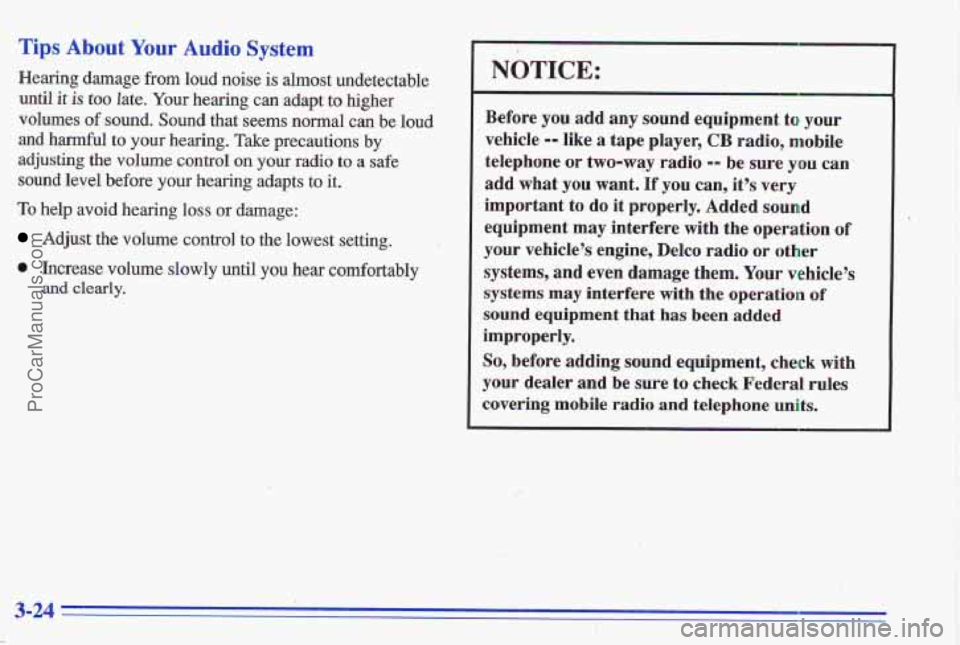
Tips About Your Audio System
Hearing damage from loud noise is almost undetectable
until
it is too late, Your hearing can adapt to higher
volumes
of sound. Sound that seems normal can be loud
and hamzful
to your hearing. Take precautions by
adjusting the volume control on your radio to a safe
sound level before
yow hearing adapts to it.
To help avoid hearing loss or damage:
Adjust the volume control to the lowest setting.
0 Increase volume slowly until you hear comfortably
and clearly.
. .. .
NOTICE:
Before you add any sound equipment to your
vehicle -- like a tape player, CB radio, mobile
telephone
or two-way radio -- be sure you can.
add what you want. If you can, it's very
important to do it properly. Added sound
equipment may interfere with the operation
of
your vehicle's engine, DeYco radio or other
systems, and even damage them. Your vehicle's
systems
may interfere with the operation of
sound equipment that has been added
improperly.
So, b'efore adding sound equipment, check with
your
dealer and be sure to check Federal rules
covering mobile radio and telephone units.
J , I.
ProCarManuals.com
Page 154 of 356
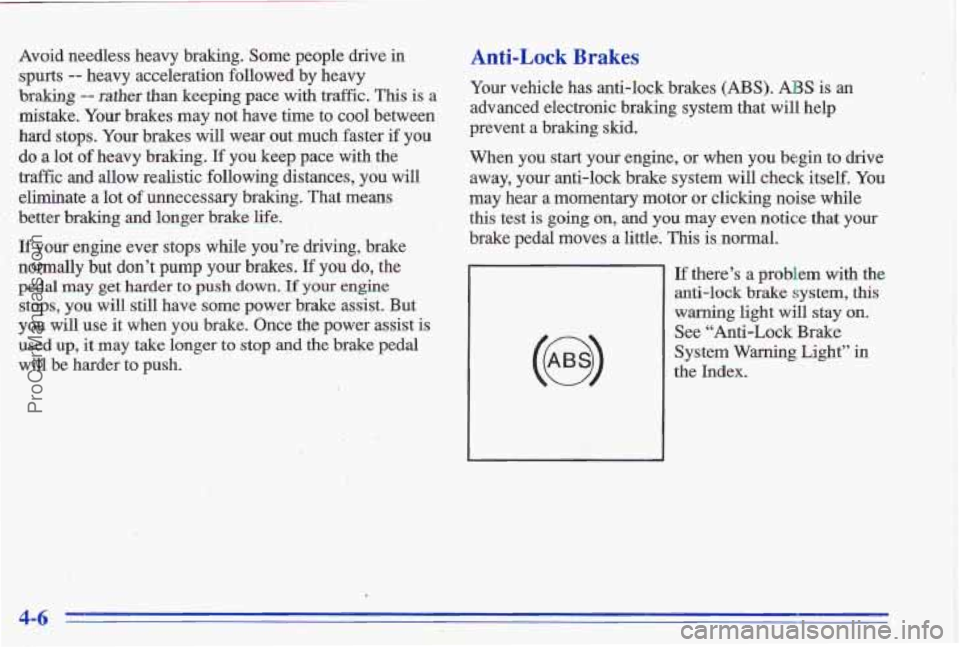
Avoid needless heavy braking. Some people drive in
spurts -- heavy acceleration followed by heavy
braking -- rather than keeping pace with traffic. This is a
mistake. Your brakes may not have time to cool between
hard stops.
Your brakes will wear out much faster if you
do a lot of heavy braking. If you keep pace with the
traffic
and allow realistic following distances, you will
eliminate a lot of unnecessary braking. That means
better braking and longer brake life.
If your engine ever stops while you’re driving, brake
normally
hut don’t pump your brakes. If you do, the
pedal
may get harder to push down. If your engine
stops, you will still have some power brake assist. But
you
will use it when you brake. Once the power assist is
used up, it m’ay take longer to stop and the brake pedal
will be harder to push.
5: , ‘
AntbLsck Brakes
Your vehicle has anti-lock brakes (ABS). ABS is an
advanced electronic braking system that will help
prevent a braking
skid.
When you start your engine, or when you begin to drive
away,
your anti-lock brake system will check itself. You
may hear a momentary motor or clicking noise while
this test is going
on, and you may even notice that your
brake pedal moves
a little. This is- normal.
(e)
If there’s a problem with the
anti-lock brake system,
this
warning light will stay on.’
See “Anti-Lock Brake
System Warning Light”
in
the Index.
4-6
ProCarManuals.com
Page 156 of 356
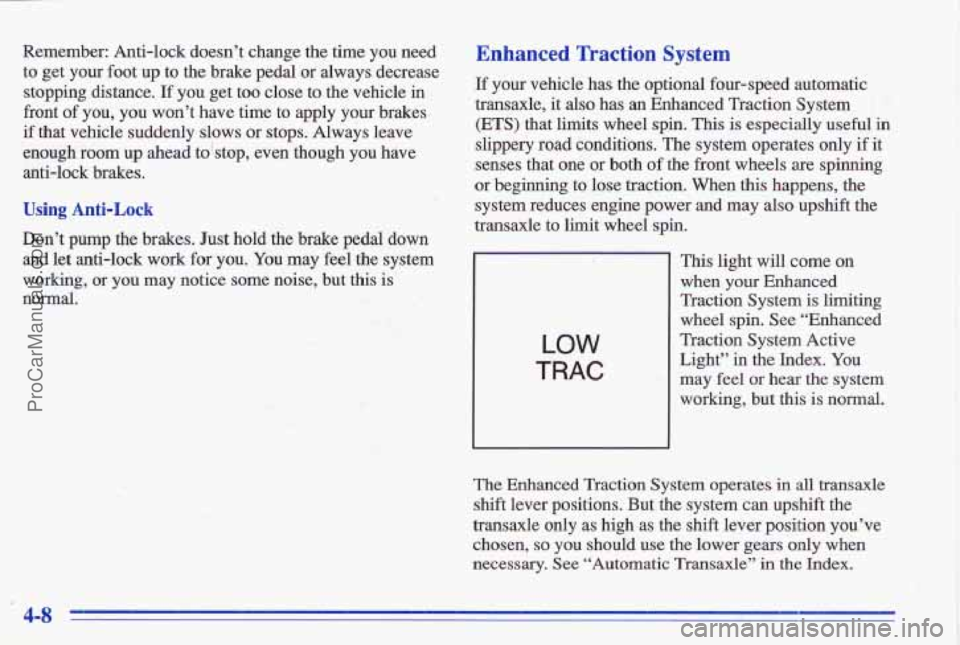
Remember: Anti-lock doesn’t change the time you need
to get your foot up to the brake pedal or always decrease
stopping distance.
If you get too close to the vehicle in
front of you, you won’t have time to apply your brakes.
if that vehicle suddenly slows or stops. Always leave
enough
room up ahead to(stop, even though you hav’e
anti-lock
brakes.
Using AntkLock
Don’t pump the brakes. Just hold the brake pedal down
and let anti-lock work for you.
You may feel the system
working, or you may notice some noise, but this is
normal.
Enhanced Traction System
If your vehicle has the optional four-speed automatic
transaxle, it
also has an Enhanced Traction System
(ETS) that limits wheel spin. This is especially useful in
slippery road condittons. The system operates only if it
senses that one or both of the front wheels we spinning
or beginning to lose traction. When this happens, the
system reduces engine power and may also upshift the
transaxle to limit wheel spin.
I
LOW
TRAC
This light will come on
when your Enhanced
Traction System is limiting
wheel
spin. See “Enhanced
Traction System Active
Light”
in the Index. You
may feel or hear the system
working, but this
is normal.
The
Enhanced Traction System operates in all transaxle
shift lever positions. But the system can upshift the
transaxle only
as high as the shift lever position you’ve
chosen,
so you should use the lower gears only when
necessary.
See “Automatic Transaxle” in the Index.
4-8 -
ProCarManuals.com
Page 158 of 356
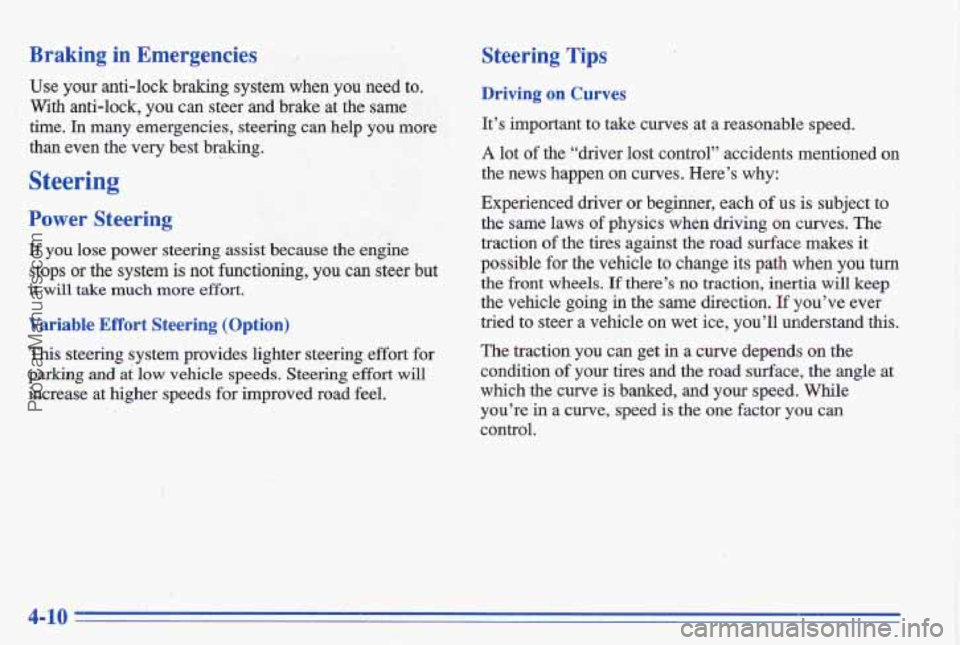
Braking in Emergencies
Use your anti-lock braking system when you need to.
With anti-lock, you can steer and brake at the same
time. Tn many emergencies, steerirzg’cm help you more
thin even the very best braking. -
Steering
Power Steering
If you lose power steering assist because the engine
stops or the system is not functioning,
you can steer but
it will take much more effort.
Variable Effort Steering (Option)
This steering system provides lighter steering effort for
parlcitlg ad at low vehicle speeds. Steering effurt will
increase at higher speeds for improved road feel.
Steering Tips
Driving on Curves
It’s important to take curves at a reasonable speed.
A lot of the “driver lost control” accidents mentioned on
the news happen on curves. Here’s why:
Experienced driver or beginner, each of us is subject to
the same laws
of physics when driving on curves. The
traction
of the tires against the road surface makes it
possible
for the vehicle to change its path when you turn
the front wheels.
If there’s no traction, inertia will keep
the vehicle
going in the same direction. If you’ve ever
tried
to steer a vehicle on wet ice, you’ll understand this.
The traction you can get
in a curve depends on the
condition
of your tires and the road surface, the angle at
which the curve is banked,
and your speed. While
you’re
in a curve, speed is the one factor you can
control.
4-10,
ProCarManuals.com
Page 163 of 356
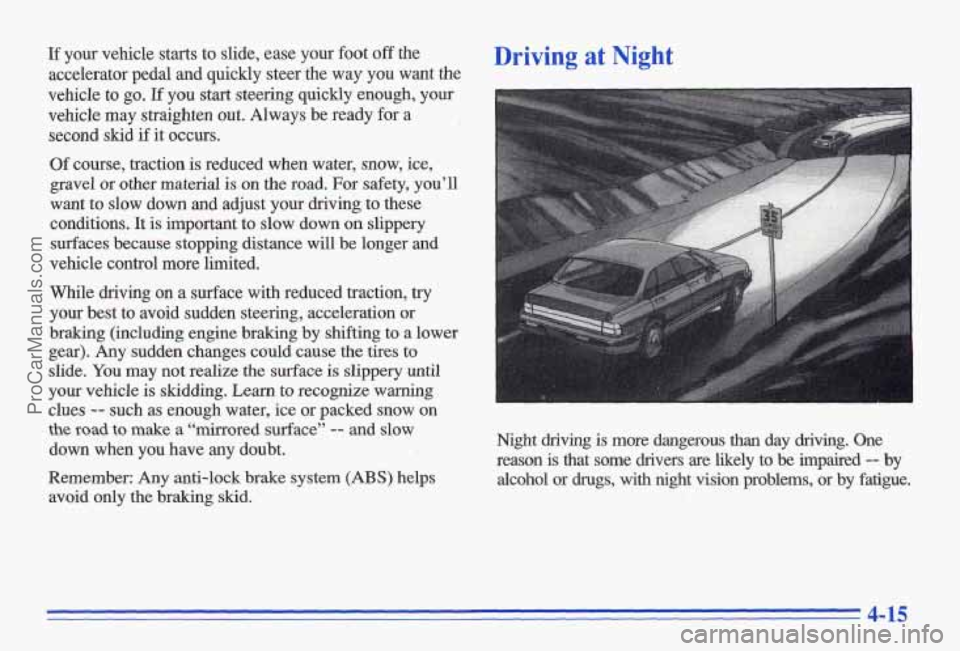
If your vehicle starts to slide, ease your foot off the
accelerator pedal and quickly steer the way you want the
vehicle to
go. If you start steering quickly enough, your
vehicle may straighten out. Always be ready for a
second skid
if it occurs.
Driving at Night
Of course, traction is reduced when water, snow, ice,
gravel or other material is on the road, For safety, you’ll
want
to slow down and adjust your driving to these
conditions. It is important to slow down
on slippery
surfaces because stopping distance will be longer and
vehicle control more limited.
While driving on a surface with reduced traction, try
your best to avoid sudden steering, acceleration or
braking (including engine braking by shifting to
a lower
gear). Any sudden changes could cause
the tires to
slide. You may not realize the surface is slippery until
your vehicle is skidding. Learn to recognize warning
clues
-- such as enough water, ice or packed snow on
the road to make a “mirrored surface” -- and slow
down when you have any doubt.
Remember: Any anti-lock brake system
(ABS) helps alcohol or drugs, with night vision problems, or by fatigue.
avoid only the braking skid. Night driving
is more dangerous than day driving. One
reason
is that some drivers are likely to be impaired -- by
4-15
ProCarManuals.com